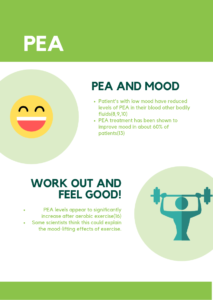Low Mood and Quality of Life
We all experience the blues on occasion. In fact, the National Institute of Mental Health estimates that 17.3 million American adults experienced at least one episode of notable sadness as of 2017.1 By the year 2030, it is predicted to be the biggest cause of disability.2,3 Feelings of sadness can have a substantial impact on the quality of life and are something most people are familiar with. However, you may not be familiar with PEA—a naturally-occurring substance in your body that has an important role in mood.
What is PEA?
“PEA” stands for phenylethylamine. It is a hormone-like substance that is naturally produced in the brain and body. PEA has stimulating effects. It can improve mood, increase attention and energy, and promote a feeling of well-being.3 PEA is made from the amino acid l-phenylalanine, which is naturally found in food.4 Serotonin, dopamine, and norepinephrine are other brain chemicals that relate to mood. PEA can partially control and influence these neurotransmitters.3,4 However, PEA has its own impact on mood as well.

PEA and Its Role in Mood
Studies show that patients who suffer from bouts of sadness have lower levels of PEA (and substances that are produced from the break-down of PEA) in their blood and other bodily fluids.2,3,5 This observation led some researchers to believe that low PEA in the brain and body can lead to low mood.4 Supporting PEA levels may help boost people’s spirits.
PEA and It’s Uplifting Benefits
One study found that giving PEA (as well as a low dose of a medication that prevents its break-down), rapidly enhanced the mood in 68% of the patients studied.6 Another study also found that around 60% of individuals with low mood reported mood improvements when they took PEA.6 Evidence shows that giving patients phenylalanine (the amino acid that is later transformed into PEA) can also help improve mood.4 PEA may even be the reason why working out makes us feel happier!
PEA: The Secret Behind Why Exercise Bolsters Mood
Scientists and doctors agree that exercise has a positive effect on mood. In fact, it is often suggested for patients with mood issues.5 One study measured PEA by-products (as a measure of overall PEA concentrations) in the urine of patients before and after exercise. The researchers found that after high-intensity aerobic exercise, patients had significantly increased PEA by-products in their urine.5 We know PEA has mood-boosting effects and it is increased after exercise. Therefore, PEA release during exercise could be the reason why exercise makes us feel so good!5
Measuring PEA Could Help to Find Targeted Therapies to Improve Your Mood and Quality of Life!
Find out more about measuring PEA.
Find a provider in your area who works with Sanesco.
Become a provider if you are a healthcare provider who is ready to help your patients find HPA balance.
References
- National Institute of Mental Health. (2019, February). Major Depression. Retrieved June 21, 2019, from https://www.nimh.nih.gov/health/statistics/major-depression.shtml
- Kaur N & Kumari B. World Journal of Pharmacy and Pharmaceutical Sciences. 2016;5(4):743-750.
- Irsfeld, M., Spadafore, M., & Prüß, B. M. β-phenylethylamine, a small molecule with a large impact. WebmedCentral, 4(9), 4409.
- Sabelli, H. (2002). Phenylethylamine deficit and replacement in depressive illness IN D Mischoulon & JF Rosenbaum (Eds.), Natural Medications for Psychiatric Disorders (pp. 83-99). Philadelphia, PA: Lippincott Williams and Wilkins.
- Szabo A, Billett E, & Turner J. British Journal of Sports Medicine. 2001;35:342–343.
- Sabelli H, Fink P, Fawcett J, et. al. The Journal of Neuropsychiatry and Clinical Neurosciences. 1996;8(2): 168-171. doi:10.1176/jnp.8.2.168
Clinical Contributor
Marina Braine
Clinical Support Specialist at Sanesco International, Inc.
Marina Braine is a Clinical Support Specialist at Sanesco. She graduated from UNC-Asheville with her Bachelors of Science in Biology with a minor in French. She likes to keep active by hiking, running, and contra dancing around Asheville.


